Germany Satellite Communications Market Size
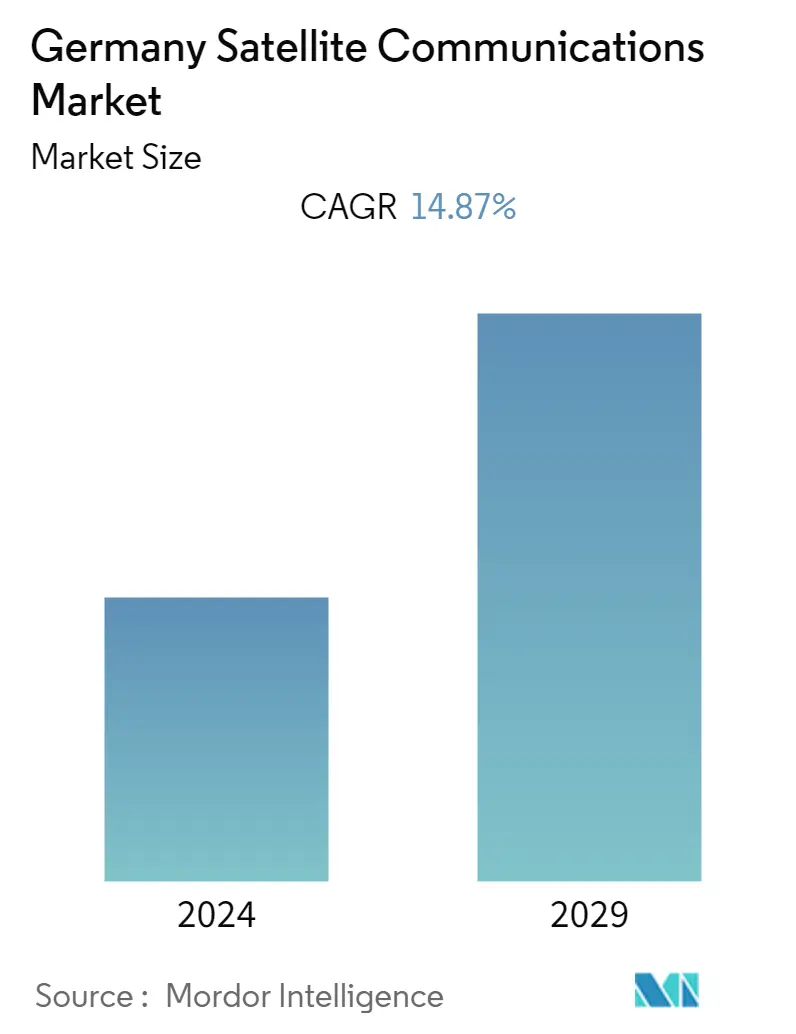
| Study Period | 2019 - 2029 |
| Base Year For Estimation | 2023 |
| Forecast Data Period | 2024 - 2029 |
| Historical Data Period | 2019 - 2022 |
| CAGR | 14.87 % |
| Market Concentration | Medium |
Major Players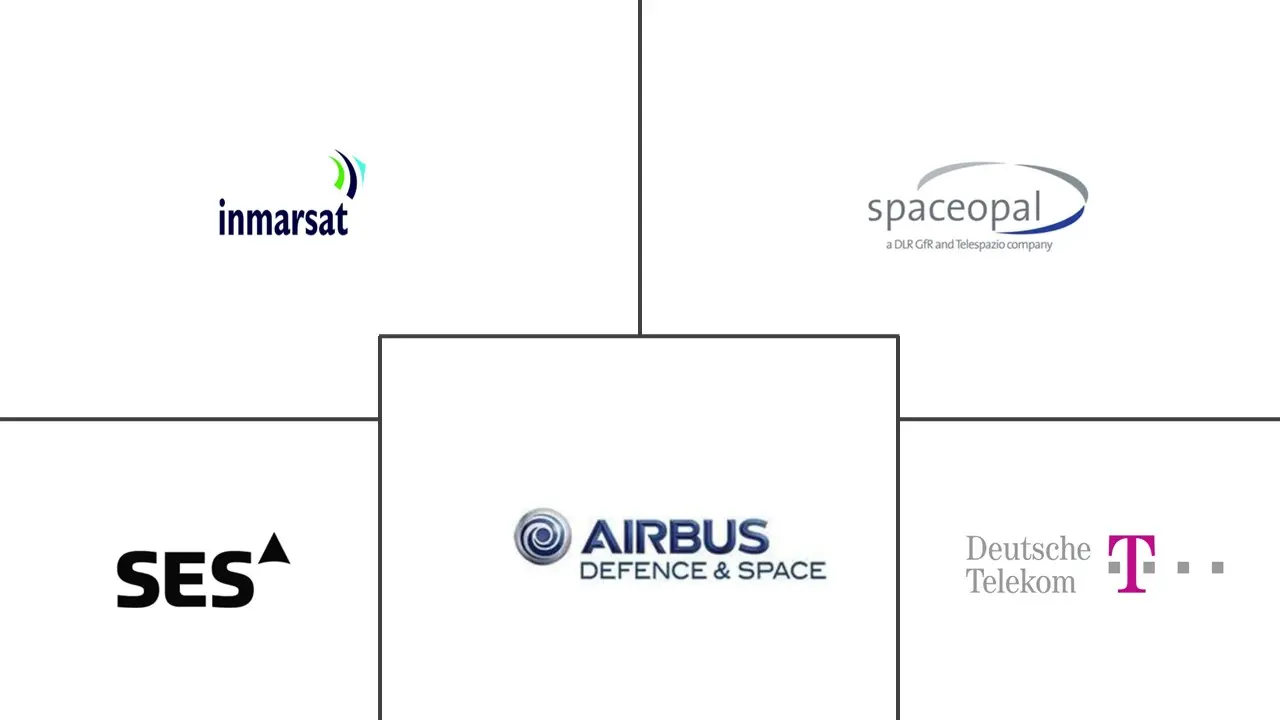
*Disclaimer: Major Players sorted in no particular order |
Germany Satellite Communications Market Analysis
The German satellite communication market was valued at USD 1.56 Billion in the past year, and it is expected to grow at a CAGR of 14.87% during the forecast period to USD 3.52 Billion by the next five years.
- Satellite communication has grown in popularity in relaying information and creating communication among military personnel in the defense and military sectors. It also aids in satellite asset tracking and remote sensing. For example, life safety at sea is becoming increasingly important in the defense sector. Various governments invest in communication technologies like navigation systems and vessel tracking. The German government is vital in promoting maritime security, as the marine industry contributes to the region's economic prosperity.
- As satellite technology developed, end users' direct access to capacity has become a severe problem. Instead of the traditional emphasis on network connectivity, ISOs and independent satellite systems are increasingly directing satellite technology toward providing services to end consumers. The conventional wisdom in satellite communication has been that the size of the receiving equipment and the power radiated from a satellite must be traded off. The most cost-effective systems for connecting a relatively small number of sites employed low-powered satellites sending signals to big stationary earth stations.
- The industry's dependence on government contracts in various areas, including the highly reliable and survivable nature of satellite communications services essential for disaster communications and backup services, may insulate the industry from some of the more severe impacts of the global pandemic.
- The demand for broadband communications remains strong and is not necessarily geographically restricted. Such demands include connectivity requirements for users on aircraft, ships, and vehicles (including first responders) operating in fixed places and while in motion. These three platforms require constant connectivity along their travel itineraries, frequently passing through unserved sections of major metropolitan centers and less heavily inhabited areas. Such developments are projected to aid in the market's growth under consideration.
- According to the Satellite Business Association, the commercial satellite industry has proven critical in controlling the COVID-19 pandemic. The demand for satellite communication has increased due to its numerous applications in providing voice, data, and broadcast communications solutions, as well as navigation, earth observation, remote sensing, and other specialized services essential for businesses, government clients, and consumers domestically and globally. International space agencies, like NASA, have employed communication satellites to illustrate COVID-19's global consequences.
Germany Satellite Communications Market Trends
Armed forces will hold the significant share
- Satellite communication has gained significant traction due to its excessive use in the defense and military sectors for transmitting information and establishing communication between military personnel. Further, it also helps with satellite-asset tracking and remote sensing. For instance, life safety at sea has been gaining importance in the defense sector. The governments of various countries are investing in communication technology, such as navigation systems and vessel tracking. The governments of countries like China, Germany, the United States, the United Kingdom, and Indonesia play a vital role in promoting maritime security, as the naval industry adds to the region's economic growth.
- Blackened and Inmarsat worked together to support the German armed forces. Inmarsat's satellite communications networks and German company Blackned's software will be coupled under the terms of the deal to offer the Bundeswehr an integrated solution. Governments can further modernize communications and implement breakthroughs like artificial intelligence, machine learning, the Internet of Things, or cloud computing thanks to Inmarsat's dependable satellite connectivity, providing a crucial infrastructural link.
- Further, Airbus completed the performance enhancements of the SATCOMBw satellite communications network required for the NATO commitment VJTF23 within the planned timeframe. The Airbus-operated BSg-A ground station in Weilheim, Germany, became operationally ready at the end of July. BSg-A is now fully integrated into the SATCOMBw military satellite communications network, commanded by the German Cyber and Information Space Command.
- Furthermore, in December 2021, Airbus and OneWeb signed a distribution partnership agreement to provide low Earth orbit (LEO) satellite communication services for military and governmental use. Airbus aims to offer new military satellite communication services leveraging the OneWeb constellation to select European and UK armed forces, civil protection, and security forces.
- In February 2022, the EU Commission announced plans to build EUR 6 billion (USD 6.8 billion) secure internet satellite systems. The aim is to provide reliable and fast internet worldwide, minimize dead communication zones, and improve EU member states' cohesion.
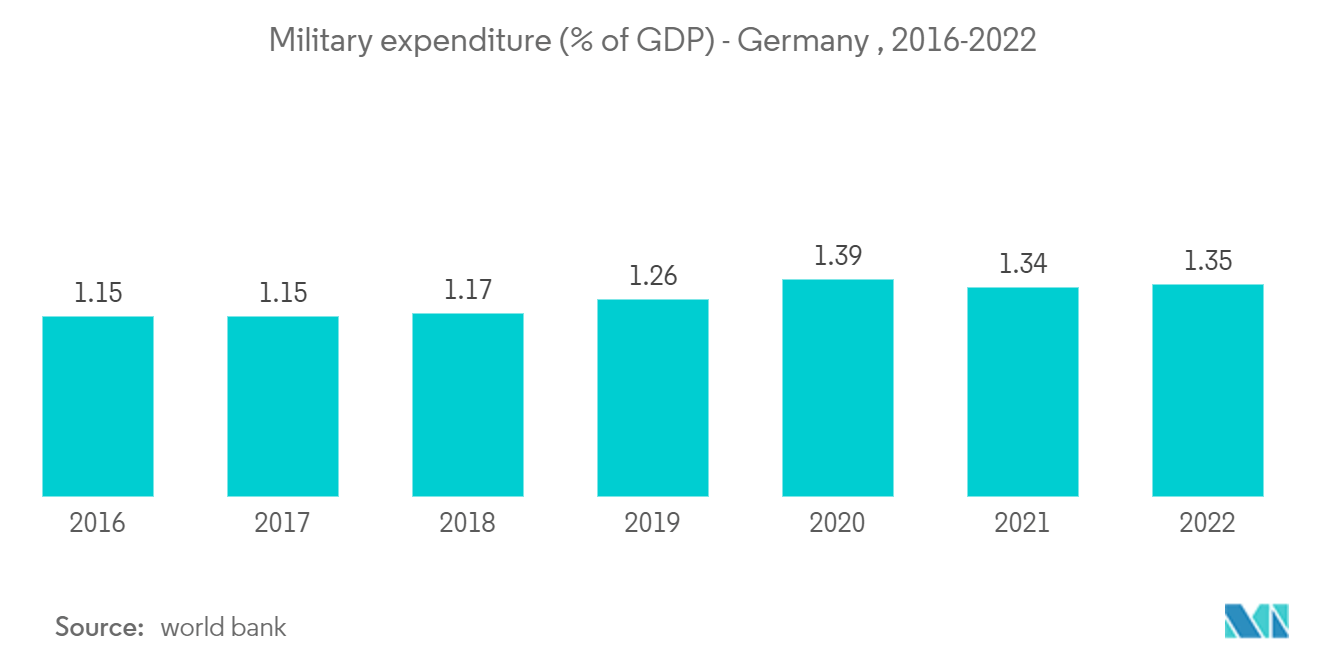
Satellite communication will transform the aviation industry
- Satellite communication is revolutionizing the aviation industry, and its impact on aviation safety is becoming increasingly apparent. Satellite communication systems enhance security, including the ability to relay real-time data on aircraft location, weather conditions, air traffic control, and communications between air traffic control, pilots, and air traffic management. The use of satellite communication is also helping to reduce airline costs.
- Airlines can reduce fuel consumption, maintenance costs, and overall efficiency by providing timely information. For example, airlines can use satellite communication to monitor fuel levels and adjust flight paths to reduce fuel costs. In addition, airlines can use satellite communication to track maintenance and repair costs, allowing them to identify potential problems before they become costly.
- Increasing government dependence on SatCom is a significant source of demand for Satellite communication systems in the region. The space sector, particularly satellite communications (SatCom), is becoming increasingly important for the EU's security, economics, and competitiveness. Satellite communications have benefited defense, security, humanitarian and emergency response, and diplomatic communications.
- The German Navy's two U-212 submarines will be fitted with Indra's satellite communications technology, ten times the submarines' existing capacity. Additionally, the business will provide its communications systems to two German F-122 frigates. Additionally, Indra will provide several satellite communications equipment to the Brazilian Ministry of Defence. The contracts with the two nations total more than € 6 million. A device that can transmit voice and data at periscope depth (16-19 feet) at 128 Kb/s in the military X band will be installed on U-212 submarines. Government satellite communications are only permitted in this band, ensuring more confidentiality and availability than commercial networks.
- GOVSATCOM will be part of the EU Space Programme (2021-2027), which will use space's capabilities in satellite communications to enable and facilitate the implementation of Member States or EU policies connected to citizen security. In regions with no ground infrastructure (e.g., sea, air, rural areas, the Arctic region), or if the current ground infrastructure is unstable, damaged, or destroyed, access to GOVSATCOM is essential (e.g., due to natural disasters, crises, conflicts).
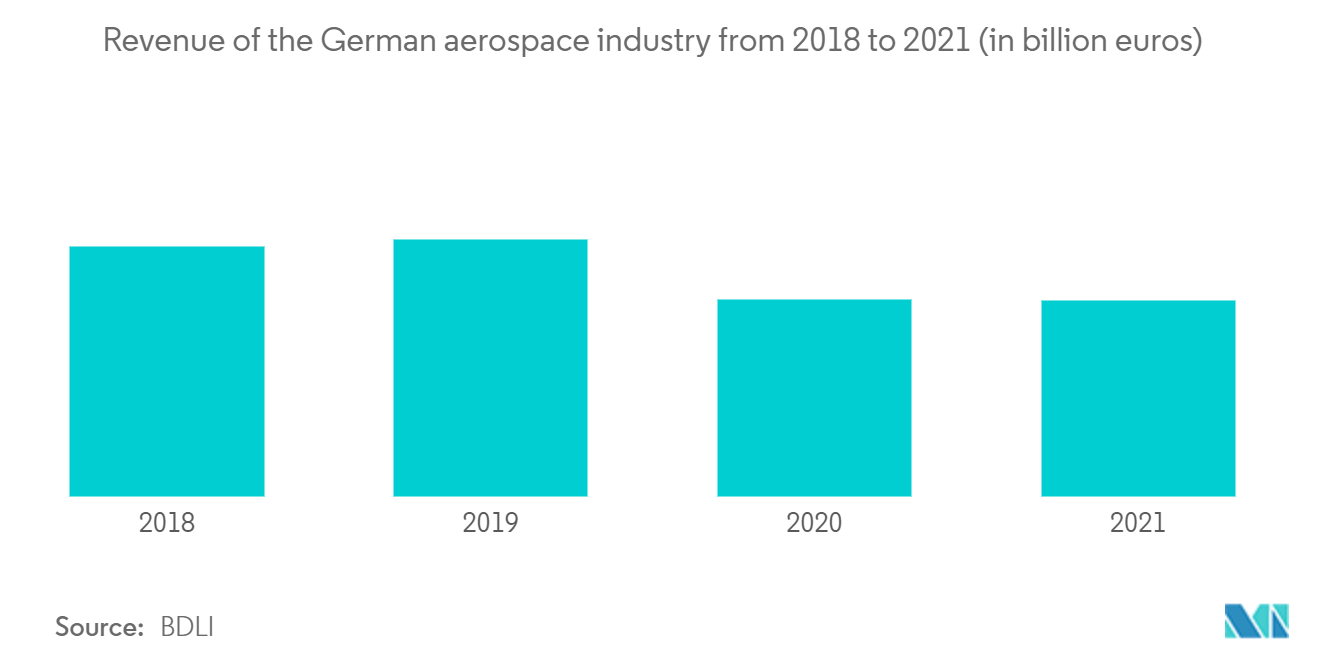
Germany Satellite Communications Industry Overview
German satellite communication (SATCOM) market is highly fragmented, with major players like Inmarsat global limited, Spaceopal GmbH, Airbus Defence and Space GmbH, and Deutsche Telekom and SES SA. Players in the market are adopting strategies such as partnerships, innovations, mergers, and acquisitions to enhance their product offerings and gain sustainable competitive advantage.
- February 2023 - German military satellite communication (satcom) systems will still be run and supported by Airbus. The business has been granted a contract extension for the operation of the authority's COMSATBw 1 and 2 satellites until 31 December 2028, as announced by the Bundeswehr on 9 February. The arrangement, worth EUR 52.8 million (USD 56.7 million), would guarantee enduring access to safe satellite communications and support Germany's orbital position in space.
Germany Satellite Communications Market Leaders
-
Spaceopal GmbH
-
Airbus Defence and Space GmbH
-
SES S. A
-
Inmarsat Global Limited
-
Deutsche Telekom
*Disclaimer: Major Players sorted in no particular order
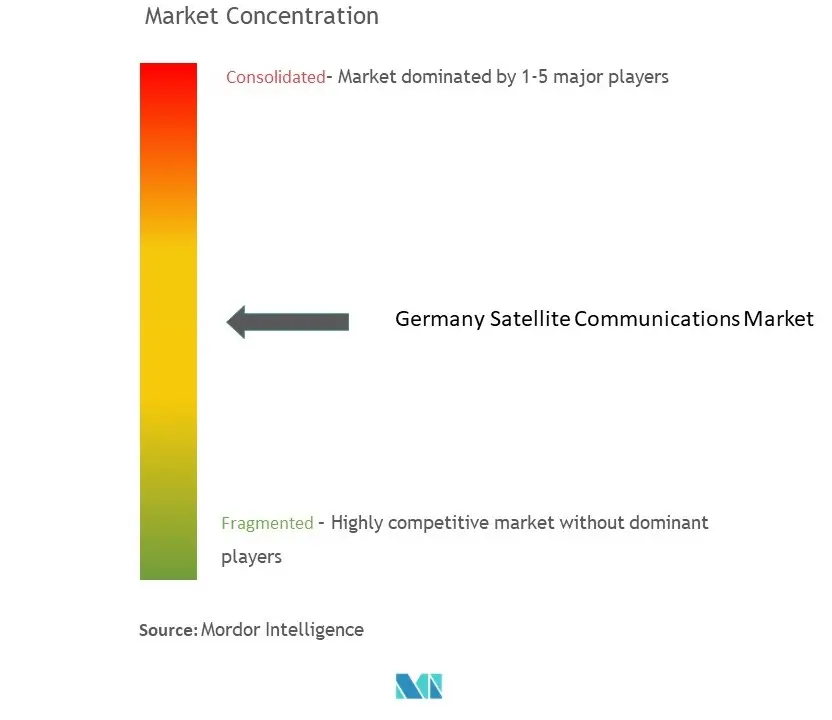
Germany Satellite Communications Market News
- February 2023 - A novel on-the-go (OTM) man-packable satellite communications (satcom) terminal has been created by Inmarsat and Hughes for use with the L-Band Tactical Satellite (L-TAC) service. The current L-TAC system offers global beyond-line-of-sight (BLOS) voice and data communications in the L-band frequency range using existing tactical radios and Spectra SlingShot radio frequency (RF) converters. It is an alternative manpack solution to the ultra-high frequency tactical communications satellite (UHF TACSAT).
- September 2022 - Europe's tallest communication satellite is launched by Ariane 5. The 8.9 m, three-story-high communications satellite, which weighs 6.525 tonnes and made up 99% of the 6.62-tonne launch mass, will provide high-speed broadband and in-flight connection throughout Europe for its operator, Eutelsat. The satellite has brand-new antenna deployment and pointing mechanisms for the antenna tracking system and other cutting-edge components, including structural panels and next-generation batteries, all created as part of the ESA Partnership Project.
Table of Contents
1. INTRODUCTION
- 1.1 Study Assumptions and Market Definition
- 1.2 Scope of the Study
2. RESEARCH METHODOLOGY
3. EXECUTIVE SUMMARY
4. MARKET INSIGHTS
- 4.1 Market Overview
-
4.2 Industry Attractiveness - Porter's Five Forces Analysis
- 4.2.1 Bargaining Power of Buyers
- 4.2.2 Bargaining Power of Suppliers
- 4.2.3 Threat of New Entrants
- 4.2.4 Threat of Substitutes
- 4.2.5 Intensity of Competitive Rivalry
- 4.3 Industry Value Chain Analysis
- 4.4 Assessment of the Impact of COVID-19 on the Market
5. MARKET DYNAMICS
-
5.1 Market Drivers
- 5.1.1 Increase in Internet of Things (IoT) and Autonomous Systems
- 5.1.2 Rise in Demand for Military and Defense Satellite Communication Solutions
-
5.2 Market Restraints
- 5.2.1 Cybersecurity Threats to Satellite Communication
- 5.2.2 Interference in Transmission of Data
6. MARKET SEGMENTATION
-
6.1 By Type
- 6.1.1 Ground Equipment
- 6.1.2 Services
-
6.2 By Platform
- 6.2.1 Portable
- 6.2.2 Land
- 6.2.3 Maritime
- 6.2.4 Airborne
-
6.3 By End-user Vertical
- 6.3.1 Maritime
- 6.3.2 Defense and Government
- 6.3.3 Enterprises
- 6.3.4 Media and Entertainment
- 6.3.5 Other End-user Verticals
7. COMPETITIVE LANDSCAPE
-
7.1 Company Profiles
- 7.1.1 Spaceopal GmbH
- 7.1.2 Airbus Defence and Space GmbH
- 7.1.3 SES SA
- 7.1.4 Inmarsat Global Limited
- 7.1.5 Deutsche Telekom
- 7.1.6 Iridium Communications Inc.
- 7.1.7 Gilat Satellite Networks Ltd
- 7.1.8 Viasat Inc.
- 7.1.9 Thales Group
- *List Not Exhaustive
- 7.2 *List Not Exhaustive
8. INVESTMENT ANALYSIS
9. MARKET OPPORTUNITIES AND FUTURE TRENDS
** Subject To AvailablityGermany Satellite Communications Industry Segmentation
The Germany Satellite Communication (SATCOM) market is defined based on the revenues generated from the types used in various end-user industries such as maritime, defense & government, enterprises, and media & entertainment, among other end-user industries. The analysis is based on the market insights captured through secondary research and the primaries. The market also covers the major factors impacting the market's growth in terms of drivers and restraints.
The scope of the study has been segmented based on the type of satellite communication equipment and services ( ground equipment (a gateway, very small aperture terminal (VSAT) equipment, network operation center (NOC), and satellite newsgathering (SNG) equipment) and Services (mobile satellite services (MSS), fixed satellite services, and earth observation services) and end-user industries (Maritime, Defense & Government, Enterprises, Media & Entertainment, and other end-user industries). Common satellite communication services include voice calling and internet access for different applications. The study tracks the key market parameters, underlying growth influencers, and major vendors operating in the industry, which supports the market estimations and growth rates over the forecast period. The study also tracks the revenue accrued through the sale of grown equipment and communication services that are being used in various end-user industries across geography. In addition, the study provides the SATCOM market trends, along with key vendor profiles. The study further analyses the overall impact of COVID-19 on the ecosystem.
Frequently Asked Questions
What is the current Germany Satellite Communications Market size?
The Germany Satellite Communications Market is projected to register a CAGR of 14.87% during the forecast period (2024-2029)
Who are the key players in Germany Satellite Communications Market?
Spaceopal GmbH, Airbus Defence and Space GmbH, SES S. A, Inmarsat Global Limited and Deutsche Telekom are the major companies operating in the Germany Satellite Communications Market.
What years does this Germany Satellite Communications Market cover?
The report covers the Germany Satellite Communications Market historical market size for years: 2019, 2020, 2021, 2022 and 2023. The report also forecasts the Germany Satellite Communications Market size for years: 2024, 2025, 2026, 2027, 2028 and 2029.
Germany Satellite Communications Industry Report
Statistics for the 2024 Germany Satellite Communications market share, size and revenue growth rate, created by Mordor Intelligence™ Industry Reports. Germany Satellite Communications analysis includes a market forecast outlook to for 2024 to 2029 and historical overview. Get a sample of this industry analysis as a free report PDF download.



